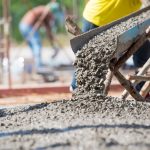.1. Providing a shade porch-A porch will help break the sun rays and reduce its penetration into the interior.
2. Choose sites and orient your house to take advantage of the naturally occurring wind flow. That is more openings should be along the inward and leeward side of the wind.
3. You can make your windows tall on opposite sides of the room to give good cross ventilation.
4. You can also create a smaller opening directly up on top of the normal bigger ones in the room-This is called “stack effect” whereby hot air generated from the ground naturally moves up to be replaced by cooler air from the top this will make the air circulate better and will also reduce the temperature as new and fresh air enters from the smaller top windows into the room and replaces the hot ones closer to the ground.
5. High walls also help to reduce temperature, that’s why most buildings with high volume of traffic are always very high-mosque ,church , halls etc. The same principle of hot air navigating and finding ways of escape from the building through several vents and other channels.
6. Minimize the numbers of windows facing East and West or totally avoid it if possible to avoid sun rays of rising Eastern sun in the morning and intense western setting sun in the evenings.
7. Provide properly sized overhangs for your windows and doors will also help in reducing heat in the home.
8. You can also plant trees around home especially leafy or deciduous trees which will help to break the sun rays, gives cooling effect, and from your biology class emits oxygen which is useful for man and take in carbon monoxide.
9. Use of very thick solid walls to slowly absorb heat during the day and slowly releases the heat out at night. Imagine the cooling effect you experience when you enter a cave and mud houses.
10. Also thick blocks with wide hollow space can help reduce heat-When the sun rays heat the first portion of the block during transmission of the heat the hollow space help to break direct transmission to the exterior, meanwhile remember the hotter air will always find its way up to give room to the cooler air to come down (note: when you boil your water)
11. Use of natural materials helps a lot in cooling the building. Materials like thatch roof, mud etc
12. Since sun rises from the east and sets in the west, you can easily minimize the wall space facing these sides and increase the wall space facing North and South especially when you are not limited by space.
13. Use light colored roof-Light color reflects, and makes the roof reflective
14. You can take advantage of natural resources and build close to water bodies or artificial lakes- The water helps to cool the environment because the cooler water will rise/evaporate which will also be blown to your interior and makes it cool.
15. In the design of the building you can have exterior walls as part of the building but jutting out to effectively block some sun rays. This could be fins along the windows.
16. Louvered interior doors will make air flow without inhibitions in the interior
17. In design if block walls in the interior can be reduced to create room for open space for air to pass.
18. Use of dwarf walls in the interior where necessary is also an advantage.
19. You can also have openings at the top of doors for air to easily flow even through the rooms in the interior
20. Usage of awning for the exterior will make the interior cool check You can also apply shutters in windows and doors
21.Draperies ,curtains ,Venetian blinds that are tightly fit also helps to reduce heat
22. Usage of reflective windows-You can ask specifically for reflective windows from your builder. Reflective windows reflects some percentage of the sun ray thereby reducing heat in the home.
23.You can also help yourself by minimizing heat generated indoors through your appliances- Select energy efficient appliances , for example energy saving bulbs will reduce heat in your home to the conventional type.
24.Strenuous exercise and work that can be done outside is better to take them out.
25. By your actions too you can reduce the level of heat generated indoors by simply scheduling the use of your kitchen and laundry appliances in the cooler mornings and night.
26.Of course plant gardens in your home.
27.The paint color of your wall will reflect some percentage of sun ray when is light. Make your wall color a light one
28.When you have roof vents, gable vents etc in your building, the heat generated inwards will have a wider means of escaping and the cooler air too can be drawn inside.
29. You can also have pergolas
30.Make your plastering smooth, it will reflect better to rough plaster.
Conclusion: 30 steps to making your home cooler
Here are the 30 easy steps to make your home cooler. Remember that you could install solar power sets in your home to run fans and keep your body cool too.



